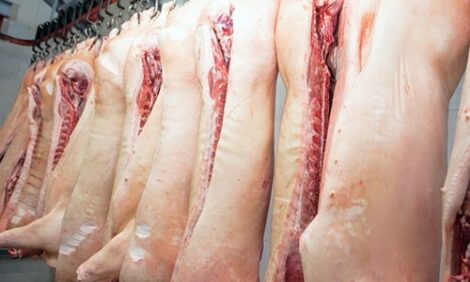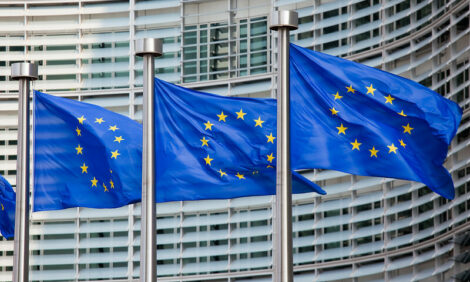 |
| Loose housing is becoming a key feature of Danish production. Welfare and green issues are shaping the industry as it strives to retain global market share in an increasingly competitive market place. |
 |
| Danish strength is it's co-operative structure and ability to market cuts rather than carcases. It's unilateral genetic and health strategies, such as its industry-wide Salmonella control programme, has also helped to secure market share and customer loyalty for Danish pigmeat throughout the world. |
 |
| Bedding material is now used in production systems - even those with slats - as it has welfare benefits. It is a requirement for many contracts, particulalry those with UK retailers. Producers say it does keep the pigs pacified, but there are disposal issues. |
 |
| Quality and consistency throughout the production chain has given Danish pig industry premier status, but environmental pressures are increasing costs, which will have an impact on revenues. |
The fully integrated pigmeat industry will safeguard its lucrative export trade by ensuring it can meet the challenges of a tougher, greener and increasingly diverse market place, through innovation and cost effective, quality assured production.
All sectors of the pig industry are on side, and at the helm is the Danish Meat Association. A re-vamped version of the country's meat and poultry boards, this umbrella organisation has pooled resources in a bid to cut costs and duplicity.
The merger, which happened a year ago, has the full support of producers and Denmark's farmer-owned processing business - not surprising as the new arrangement has managed to reduce levy fees for farmers to 5.5DKK per pig slaughtered (down 0.75 DKK), and cut the processor levy in half.
The pig industry dominates, because it is Denmark's primary livestock sector. However, within DMA each individual board retains its independence - with its own agenda - so producers have seen little change.
"We're larger, but leaner with an improved service and better economics," said Henrik Lauritsen DMA's Quality Assurance Manager. The association has reduced budgets by 25 per cent by cutting administration costs alone. It is in much better shape to tackle the challenges faced by Denmark's livestock sector.
Stability with potential
The pig industry is holding it's own in spite of price pressures, increasing legislation and global market changes. Production is static and exports have grown slightly. Denmarks is still the world's leading exporter of pigmeat and pigmeat products and, with more opportunities coming from China and the Far East, DMA believes it has a very strong future.
"China has significant market potential. The economy is driving pork consumption," said Karsten Flemin, Market Analyist with DMA.
And demand is growing rapidly. Pig slaughterings are rising year on year - with a predicted six per cent or more increase for 2007. However, the recent PRRS outbreak and subsequent pig shortage may now force China to source elsewhere.
However, it is not the Far East where Danish export sales are growing, more so within Europe. Quality at a competitive price is what driving the market here and the Danes can produce the goods.
EU pig production is up, by 1.7 million pigs and Danish numbers top the list. Estimates suggest a 3.8 per cent rise in production. However, Mr Felmin says this is not the case. The tether ban, which came into force last year, and the subsequent change over to alternative sow housing systems, has pulled back national herd numbers. The figures are more likely to stand between 2.0 and 2.5 per cent. It's still the highest growth in Europe and DMA believes the trend will be sustained.
"We see emerging markets in Romania and our potential has not been fulfilled there. And exports within the EU continue to grow, particularly to Italy and the UK," he added.
Food safety and assurance are increasingly important and the Danes lead the way. The co-operative structure of its pig sector has enabled a degree of standardisation and the implementation of industry-wide initiatives such as its Salmonella Control Programme. Introduced in 1993, the programme covers feed surveillance, on-farm monitoring and management and meat inspections at the abattoir. The integrated approach has proved immensely successful and to date Salmonella is not an issue in Denmark, said vet Vibeke Møgelmose, head of food safety at the DMA.
"The number of reported Salmonella cases in humans due to pork was 215 in 2005, compared with more than 1,100 cases in 1993 when the programme was introduced," she explained. The Salmonella programme has full traceability and problems can be sourced to origin - and it's a major marketing advantage. The system is constantly evaluated to ensure it is cost effective. However, the industry now feels that it has gone as far as it can with on farm surveillance; the focus is now on enhancing controls in the processing sector.
Environmental pressures
On the environmental front Danish producers are facing tough decisions and significant investment. Legislation now dictates that pig producers must own at least a third of the land mass required to dispose of effluent and manure. As a result land prices are racing skyward. Prices range from £10,000 per hectare in Zealand to more than £25,000 in areas of Jutland. Pig farmers must also demonstrate secure contracts for waste disposal on neighbouring land and/or through contract farms. They are also legally binding.
"The environment is the pig industry's greatest challenge," said Henrik Lauritsen. "Producers are leaving the industry because they cannot afford the land needed to sustain their business, but fortunately their pig numbers are being taken up by other herds which can expand," he explained.
Slurry handling and bio-digestion techniques are proving popular options as producers can 'write off' some of their waste needs by installing processing facilities. Bio-digester plants, where pig slurry and organic waste is processed to generate methane, heat and subsequently electricity is an attractive innovation and a number of farmers are working co-operatively to fund installations.
There are more than 57 on-farm biogas plants in Denmark and more are planned. Jørgen Hinge of the Danish Agricultural Advisory Service said the interest from pig industry is purely as a means of beating environmental restraints. "Most plants are on large pig units. With limited land availability, farmers need to find ways of managing their manure. And with planning regulations, more pigs, means more environmental controls," he explained.
Mr Hinge said that this type of system had benefits because it increased fertiliser values, which contractors liked, while reducing the handling and storage costs for producers. There was also the value of the 'green' electricity produced, which was sold to the national grid. However, installation costs were extremely high and new constructions were only possible because of government subsidies.
Most farmers are more interested in a centralised scheme where they can share costs and resources. In theory, it is a good idea, but in practice it is difficult to find suitable locations, and wind power is seen as a more attractive investment, said Mr Hinge. "The amount of energy and heat produced means that biogas systems should be sited near urban areas to be effective, but planners are very reluctant to grant permission for such operations," he added.
Many pig farms are choosing to separate slurry, too. Research shows such systems have commercial viability and the financial outlay is reasonable. "Low tech plants are effective at separating phosphorus and some nitrogen from the slurry and the investment is manageable at between 500,000 to 1M DKK," said Mr Hinge.
However, there were still questions over the long term performance of these systems and the storage requirements of the separated fractions. Incineration of the fibre product was a possibility, but again that had environmental implications. Mr Hinge said that more research into higher-tech solutions was needed, but solutions were available. It's just another challenge the Danish pig industry will have to take on board.
















